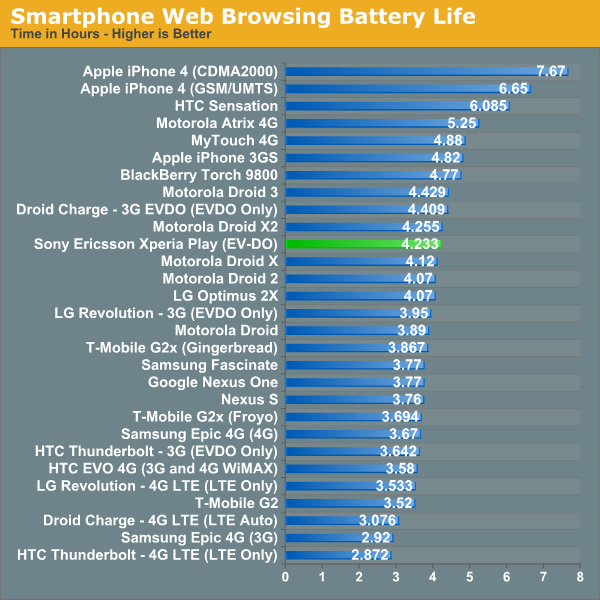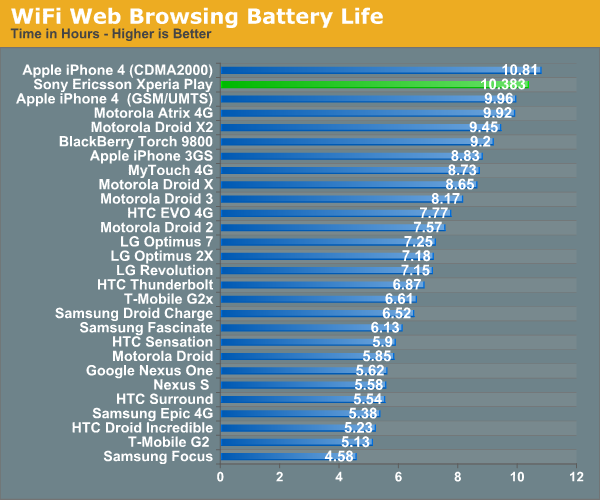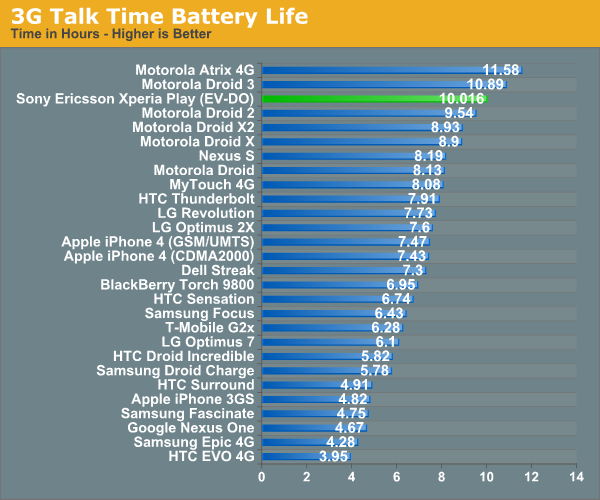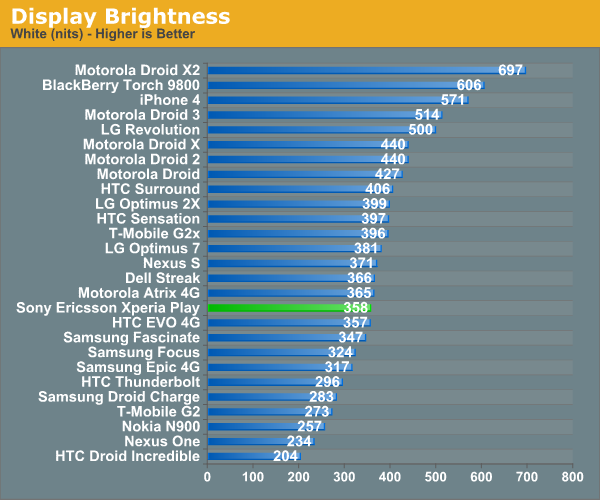The Sony Ericsson Xperia Play: Where Do You Want To Take Your Gaming Today?
by Brian Dipert on August 8, 2011 1:26 PM EST- Posted in
- Smartphones
- Sony
- Android
- Xperia Play
- Mobile
The Xperia Play embeds a single rear-mounted 5.1 Mpixel image sensor alongside a LED flash. There's no dual-sensor rear array, as in the HTC EVO 3D or LG Optimus 3D, although Sony Ericsson included a VGA resolution (640x48 pixel, aka 0.3 Mpixel) front-mounted camera for video chat purposes. The Xperia Play captured passable rear-mount camera snapshots even in low ambient illumination environments, although it doesn't come close to offering the brightest LED supplemental illumination that I've encountered.
Still imaging acceptability was unfortunately coupled with video imaging downsides. For unknown reasons (though I suspect a combination of battery life concerns and CPU performance limitations), the Xperia Play's captured per-frame video resolution is only 800 x 480 pixels (aka widescreen standard definition). I'm profoundly baffled by this shortcoming; my Nexus One contains prior-generation iterations of both the CPU and GPU, yet manages 720p video capture (albeit, admittedly, via a CyanogenMod-delivered hack), as does the silicon-comparable iPhone 4 even in an unjailbroken state. Plus, I personally found the resultant video to be even softer than SD resolution capture would normally deliver, along with a sub-par soundtrack that may be in part a reflection of the non-optimal microphone location.
Anand tested both power consumption and display attributes prior to shipping the Xperia Play to me, so the data that follows comes straight from him. Here's the comparative battery life of the Xperia Play versus other handsets AnandTech has tested, when web browsing both over EV-DO:

and over Wi-Fi:

And here's the 'talk time' battery life comparison:

Anand then measured the Xperia Play's display brightness and contrasted it (pun intended) with other mobile phones:

The default display intensity is a bit dim, perhaps reflecting a decision made by Sony Ericsson to stretch the between-charges usage, but the display acquits itself well versus other gear I've handled in the past once you bump up the setting a notch or few. Its viewing angle is also passable albeit not stellar, and it's much easier to see in daylight than is an OLED alternative. And if you do the math on its atypical 854 x 480 pixel resolution, you'll see that not only does it notably exceed that of the PlayStation Portable (480 x 242 pixels), it also works out to be an exact (to within a few decimal places) 16:9 ratio. This means no cropping, no black bars, and no squishing-or-stretching distortion when watching widescreen movies.
Apologies, by the way, for the lack of a display black level brightness measurement, therefore the associated absence of a contrast metric. Anand had mistakenly thought the Xperia Play had an AMOLED screen (it's a LED-backlit LCD), therefore only took a white level brightness measurement before sending the handset to me, and I don't currently own a colorimeter.










34 Comments
View All Comments
SilthDraeth - Monday, August 8, 2011 - link
I wonder why they chose a Dpad for directional control vs a flat analog slider pad reminiscent of the Nintendo 3ds?I would have thought the analog slider pad would have better mimicked the capacitive touch circle control. In fact I probably would play some more N.O.V.A 2 if my Samsung epic had a analog slider pad.
I wonder, if maybe they didn't do it, because at the time the phone was designed and released, the 3DS hadn't came out, and no one had thought of it yet...
LordOfTheBoired - Tuesday, August 9, 2011 - link
Interesting theory, but there's a problem with it... the PSP had a flat analog slider long before the 3DS did.It's also an input that is largely reviled by the fans, and not without justification.
Though the fans think the problem is that it isn't a "real stick"(actually, two of them) rising high above the face of the device like a home gamepad(specifically, like the DualShock series of gamepads), and to hell with pocketability. See also: the upcoming PS Vita.
Personally, I think it was just a poorly-considered implementation of a good device.
The fault as I see it is that it's topped with a convex thumb-piece and the centering springs are fairly high-tension. Though the awkward location doesn't help matters either(I'm pretty sure the slider was shoehorned in late in the system's development and it was intended to be digital-only).
I'm rather disappointed to know the capacitive disks don't work, as I thought they were a good idea. Especially as it avoided the preference for cardinal directions in dual-spring potentiometer designs(a very strong preference in the case of the PSP's high-tension slider).
Guspaz - Tuesday, August 9, 2011 - link
Good idea, terrible implementation. While I'm not a PSP owner,and have only played with them a bit, my experience was that the problems were:1) Horribly positioned. My hand cramped up using the analog nub on the PSP while simultaneously holding the PSP with that hand
2) Concave form factor made it harder to grip
3) Rough texture was uncomfortable
4) Spring put up too much resistance
5) Too small and not enough range of motion
The 3DS circle pad attempts to address all of these complaints, and while it isn't quite perfect, it's a good enough implementation that it can compete with "real" analog sticks rather nicely. Of course, by giving it good positioning, it makes the 3DS' d-pad uncomfortable to use, but you can't have it both ways. Anyhow, a circle-pad would certainly fit on something like the xperia play. In fact, I wish that the circle-pad was on more devices, but unfortunately Nintendo's patents will prevent that. Hopefully Sony can come up with their own similar slider pad that, if not identical to the circle pad, at least makes the same corrections.
MacTheSpoon - Monday, August 8, 2011 - link
This first gen phone is underwhelming, but I hope they stick with the concept and iron out the problems. The underlying concept of a smartphone with physical game controls seems spot-on. I'd love to play console-type games on my phone using physical controls instead of multitouch.ImSpartacus - Monday, August 8, 2011 - link
The first gen phone is underwhelming and ever single phone after that will follow similarly.Why? The Vita. I can't understand why Sony thought it was a good idea to split the Vita and Xperia Play. If you want to compete with iOS gaming, you can't do it with two distinct devices. Sony needs a unified gaming device. They are welcome to sell a wifi version (a la iPod Touch), but their flagship needs to be a phone.
seamonkey79 - Monday, August 8, 2011 - link
^ ThisExodite - Monday, August 8, 2011 - link
Because Sony isn't the same company as Sony Ericsson?It's not even a subsidiary, indeed SE is made up from far more of the old Ericsson phone division than it is Sony.
This isn't in any way, shape of form a 'Sony' phone - Sony doesn't do phones.
ImSpartacus - Monday, August 8, 2011 - link
Then Sony should do phones.Zoomer - Tuesday, August 9, 2011 - link
Not outside Japan, anyway.Guspaz - Tuesday, August 9, 2011 - link
Sony Ericsson is 50% owned by Sony and 50% owned by Ericsson. They make Walkman-branded phones, Cyber-shot branded phones, BRAVIA-branded phones... Sony and Ericsson could clearly have come to an agreement if Sony had wanted to do this all in one device.After all, the XPeria Play and Vita are similar architecturally. They both use ARM SoCs (a departure for Sony in a game console), although the XPeria Play is using a Qualcomm Snapdragon with an Adreno GPU while the Vita is using a quad-core ARM Cortex A9 with a PowerVR SGX534MP4.
In actual fact, the hardware in the Vita is identical to the iPad 2 except doubled (same CPU/GPU, just double the cores each).